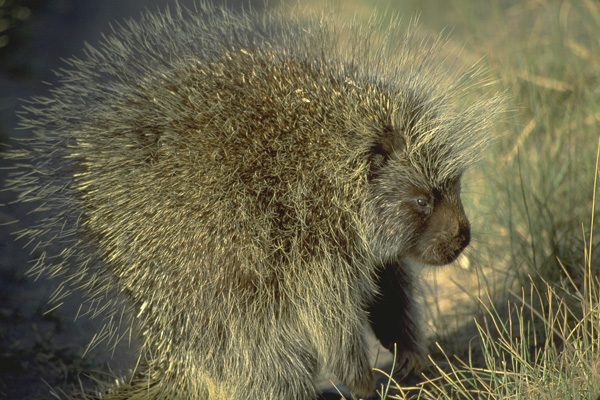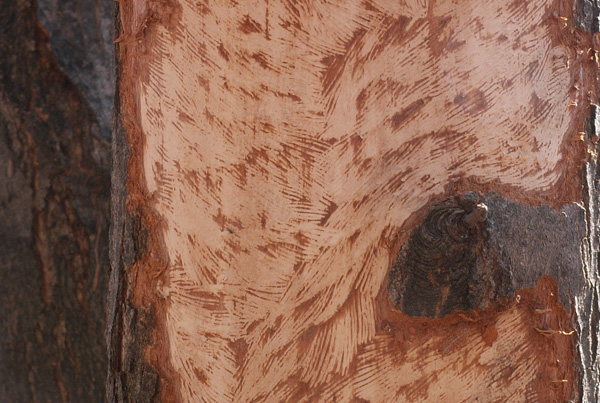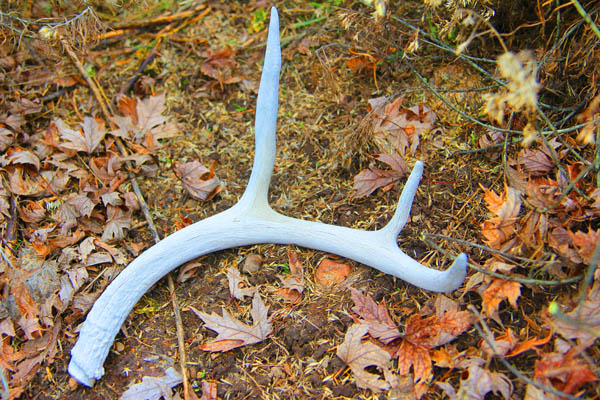Be sure to check for porcupines when you make a late-night bathroom run.
This is one of the first things you learn upon arriving at Scout camp in the Pennsylvania woods.
The adolescent mind has no trouble imagining various exceedingly unpleasant scenarios that could emerge from such a midnight meeting. Ouch.
And unlike most of what I learned at Scout camp, this bit of lore was actually based on truth.
Porcupines really do frequent backwoods outhouses.
Because they eat them.

I’m serious. I know that porcupines are kind of like over-exposed celebrities. They attract rumor and tabloid-style coverage, most of it myth. This is to be expected for something covered in barbed quills.
But this story is true. It’s well documented in the literature, and it’s based on porcupine physiology.
North American porcupines (Erethizon dorsatum) feast on a high-potassium, low-sodium diet of foliage, causing them to excrete high levels of sodium. This creates a sodium-potassium imbalance.
While research has shown that porcupines can physiologically tolerate this imbalance at times of the year when their mobility is limited (like during heavy snowfall), most of the year they have a craving for salt.
They often seek out natural mineral licks for their needs. But the human environment is not low in sodium. We have created a salty feast for the porcupine.
Like outhouses. Urine is high in sodium. Combine this with the notoriously bad aim of boys, and you have porcupine nirvana.
The walls of my old Scout camp outhouse looked like they had been run through a wood chipper, so heavily were they gnawed by quilled rodents.

What else does a porcupine chew?
The salt craving leads the critter to all sorts of strange places. Some items on this list are cited in the literature; others seem more anecdotal. And at least one is just flat-out crazy.
Cars. Roads are de-iced with salt in the winter. This salt coats the car tire and splashes up underneath the auto body. As night falls, the porcupine stealthily chews on car parts, many of those parts out of sight of the owner.
This created a harrowing situation for nature writer and ethicist Tovar Cerulli:
[The porcupines] had nibbled through a brake hose… a problem I discovered on the way to work the next morning, when my foot went to the floor without slowing my pickup at all. I was grateful for a long driveway and a hand brake. The truck—our only vehicle at the time—was out of commission for three days while a replacement hose was located.
Cerulli writes eloquently of cultivating a mindful relationship with wildlife. This incident tested him. Sorely.
Axe handles and canoe paddles. Human engages in vigorous activity. Sweats on tool. Gets tired. Leaves tool outside. Porcupine eats.
Firearms. The porcupine practices a unique form of gun control. It eats them.
Like the previous example, this one relies on a sweaty outdoors enthusiast leaving a tool outside. This is a particular favorite of pulp outdoor literature.
But like other staples of this genre – charging wolverines and the big one that got away – it seems to happen more in print than in real life.
Saddles. Horses sweat too. Especially horses on long backcountry pack trips. I imagine salty leather is somewhat akin to the porcupine version of beef jerky.
Your face. The Catskill Mountaineer offers this tantalizing sentence: “Hikers have reported porcupines licking their skin while sleeping.” Really? I cannot imagine waking up to a kiss from a quilled rodent. Has this ever actually happened?
But in case you’re thinking about not rinsing off your face after a hard day’s hike on the Appalachian Trail?
Well, you’ve been warned.

Plywood. The resin used to bind plywood is sodium based, making it an ideal porky snack. There is a patent for “porcupine proof” plywood, based on a potassium resin, but it doesn’t seem to have caught on.
Porcupines used to be considered a much bigger problem for home owners. In the 1800s, when pioneers kept large quantities of salt in their cabins, porcupines reportedly chewed through walls at night to get at the stash.

Antlers. Antlers are rich in minerals and shed every spring. It’s a veritable feast. Provided the porcupine beats eager shed hunters.
Bigfoot bones. Faces, and gunstocks, are at least in the realm of possibility. This one belongs to science fiction, and is almost too silly to mention.
But start researching porcupine diets and you’ll soon land in Bigfoot’s lair.
Cryptozoology fans posit that the reason no one ever finds the bones of dead sasquatches is because – you guessed it – porcupines eat them!
Of course they do.
This idea was popularized on the regrettable Animal Planet show Finding Bigfoot. Of course, this is the same bastion of journalistic excellence that claimed sasquatches are attracted by raves.

Porcupines do dine on bones. But anyone who spends much time poking around the woods knows they don’t eat every bone in the forest.
Not that this fact is likely to dissuade the True Bigfoot Believers. It can dissuade the rest of us from regarding cryptozoology as science.
Tree bark. Once, society regarded porcupines as a major nuisance. This was based not just on its love of salt, but also its dietary staple of tree bark.
Anything that girdles trees must harm the timber industry, or so conventional wisdom went at the time.
Many states paid bounties on dead porcupines until the 1920s (and in the case of New Hampshire, until 1979). When actual research was conducted they found that this was untrue. Not “porcupines eat sasquatch” untrue – but in no way a major factor in timber harvests.
The reintroduction of fishers, a major porcupine predator, keeps their populations in check.
Today, porcupines can be at worst a localized problem – although a not insignificant one is your car has no brakes or you’re literally up the creek without a paddle.
Still, they’re fascinating critters. Just keep your valuables out of reach, and watch where you sit in backcountry outhouses.




this was creepy
I used to see porcupines regularly in my rural area of Washington state, and my dog had an occasional encounter. But I haven’t seen one for literally years now, and I know they have a lot of enemies around here (orchardists, loggers, vehicles). I find it ironic that Washington state’s Dept. of Fish & Wildlife is working on restoring fisher populations (for which porcupines are a major food source) but still instructing people about how to trap and exterminate porcupines. And I don’t think the state has done any study of porcupine populations to learn about population trends.
Please send me your newsletter
Im a big foot believer but yes that show is ridiculous; anyway lots of creatures gnaw on bones its part of the forest cycle. But my interest was, would they shred pine cones and leave a pile of seeds almost as if they sucked on the inside like we would on a ear of corn after devouring the kernels? yes this is related to sasquatch activity.:).
The captions under the pictures really made this article all the more enjoyable for me
Ah, finally a nice article about my favorite critter. Porcupine numbers appear to be declining just about everywhere. Enjoy these adorable forest/grassland/desert denizens whenever you see them.
Would love to find a method short of shooting them to stop the destruction of my dwarf pear trees. They break all the branches when climbing to get to the fruit. Have tried all kinds of methods but the lowest branches are too close to the ground for metal trunk wrap to work. They dug under a solid metal fence placed a couple of feet away-didn’t know they would dig like a ground hog. Won’t enter a live trap. Might have to resort to elimination via bullet. This guy comes out most anytime it wants-even mid-day doesn’t stop it.
Hiking in Mt. Rainier National Park, we noticed a deposit of quills at the edge of a platform toilet(comes with a view). Does a porcupine leave quills as a down payment on such a fine piece of property? There were no visible chew marks – yet.
Great Article Matt! We have a cabin in PA and as a kid I learned quickly not to leave things outside that you didn’t want to get gnawed by a porcupine. I don’t recall ever having issue with our outhouse, but chairs, axe handles, vehicles, were all regularly chewed on. We’ve had more than one person stranded up there after porcupines chewed on their vehicle.
Thanks for the memories.
Cory
I had those distinctive chew marks at all around the support logs on the porch of our home in MT a couple of summers ago. I had no idea what that was from…neither did anyone else! Then one night my dog was barking and I saw a large lump of quills or fur…I wasn’t sure…moving around the deck area. There was no front or back that I could tell! It ended up in a corner…apparently it was a large porcupine. That’s what had been feasting on the logs…so I had them ringed in a copper skirts to stop it from chewing around them.
Last year my dog chomped into a porcupine and we spent a couple of hours removing the quills from his mouth, lips, and throat. Not fun. A couple of nights ago I heard scratching on my house and I thought it was Kitty, wanting to come in. I opened the door and about 18 inches from me was this glorious round ball of pure white quills! It looked like some kind of Christmas ornament. Now, I am worried about my car, my cats, and myself. What to do…..
I sure hope this article doesn’t incite a porcupine killing spree across the country.
Reading this brings back the thrill of driving down unpaved roads in Vermont in a VW bug with no brakes. Eventually we hit upon the plan of totally enclosing the vehicle in wire upon arrival at the weekend cabin. Labor-intensive but effective. The population of porcupines was so high one year that the departed were buried vertically in the garden (to save space).
Fascinating article! Who knew that a need for salt could lead porcupines to such extremes.
Hi Jon,
Have just read your blog about porcupines with great interest.The “B’S” are back here hungrier than ever. They have literally devastated everything with a tuber, or corm in our garden in the last few days.
David and I have come to loathe the critters.
Hope you’re well
Ciao for now,
Eleanor and David